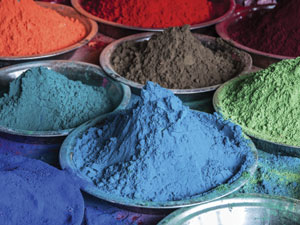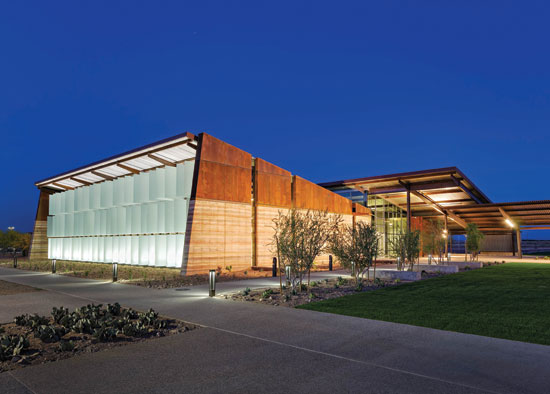Talking Color
In long ago times, color was provided by readily available natural materials—red ochre, a form of iron oxide; yellow ochre, an iron silicate; black pigments from charcoal; white pigments from calcium sulfate, or gypsum; softer greens and pinks from vegetable dyes. Over the centuries, architects have created drama in buildings through color, be it derived from pigments, paints, stained glass, or mosaics. In recent history however, despite the emergence of color science, color has been the most neglected aspect of architectural design, taking a back seat to spatial dimension. Conservative choices, such as shades of whites, beiges, bronzes, metallics, and grays have remained the leading color choices for many years, arguably to create an aesthetic that will not seem quickly dated.

Pigments provide the color and often determine the performance of a coating.
Still, building owners and architects are increasingly re-evaluating the power of architectural color, looking to color trends and using color to achieve certain goals. Restaurants are using color to stimulate the appetite, industrial designers to increase efficiency, relieve eyestrain, and reduce fatigue. Designers of schools are employing color to reference various developmental levels from bright primary colors for young children to more serene blues and greens conductive to study for older students. Healthcare designers use color to inspire confidence and promote the healing process, with some practitioners claiming the right colors and combination of colors can actually enable medical diagnosis and surgical performance.
There is increasing evidence that color has a profound effect on the human experience as well as in changing and improving the aesthetic appeal of particular areas. As color trends take stronger root and the power of architectural color is re-evaluated, architectural coatings will play an ever-increasing role. Accordingly, architects should become familiar with the fundamentals of these coatings and how to specify them for enduring aesthetic results.
The Chemistry of Color in Architectural Coatings
Architectural coatings are comprised of a resin and a pigment. The primary function of the resin is to provide adhesion, flexibility, hardness, moisture and chemical resistance, and resistance to UV light. Pigments provide the color and often determine the performance of a coating. It is the chemical resistance of the pigment that is key. Pigments are either inorganic or organic, and in some instances it takes both types to create a particular color space. Inorganic pigments are metal oxides and mixed metal oxides that have a high resistance to fade and are the most heat stable, chemically inert, UV- and weather-resistant pigments known. Generally, inorganic pigments are beige, tan, brown, and other earth tones.
Organic pigments, which are carbon based and often made from petroleum compounds, produce bright, intense colors; however, they are susceptible to fading and heat as UV and oxygen can penetrate organic pigments, breaking their chemical bonds.
The larger average particle size of inorganic pigments makes them opaque while the smaller particle size of organic pigments renders them transparent. In other words, organic pigments produce brilliant shades but with low coverage while inorganic pigments produce architectural coatings with high coverage and are used mainly where high opacity is required.
Applying Color to Metal—Coil and Extrusion
The way color on a building appears to a passerby is a function of the pigment itself, the substrate, and any clear coating applied over the color, as well as the method by which the paint has been applied. With architectural metal components, color is generally either spray applied or coil coated. Each method has its own unique characteristics. Coatings are generally applied to components that are already formed, while coil coatings are applied to flat metal that is later shaped into panels and pieces. Extruded and curtain walls components, then, will be spray applied, while roofing and side wall panels will be coil coated.
In spray application, the coating comes out the tip of a gun, and most applications are electrostatic, that is, an electrical charge is given to the atomized paint, and the part is grounded, so an electrical field is established between the gun and the part. The paint travels along the electrical field to that grounded part. The advantage here is that electrifying the coating allows for efficient transfer to the substrate during application.
Coil coating is a continuous and highly automated process for coating metal before fabrication. In one continuous process, a coil of steel or aluminum that can be as wide as 72 inches and moving up to speeds as fast as 700 feet per minute is unwound and both the top and bottom sides are cleaned, chemically treated, primed, oven cured, top coated, oven cured again, rewound and packaged for shipment. Typically the applicator roll turns in the opposite direction of the strip, and thus the process is called reverse roll coating. This process can place a significant shear on the coating, but it allows for high levels of control of both film thickness and color.
The difference in the two application methods and their planes of application necessitates a different rheology for the coatings. Rheology is the science of flow and deformation. Flow phenomena can be very complex. The simple action of stirring paint in a can involves flow patterns that can be a challenge for exact mathematical analysis. In coil coating, the application plane is horizontal and a high shearing stress is applied to the coating for a brief period when the application roll meets the moving metal strip. Having only a horizontal application plane means that after application, the coating will not run or sag. As a result of coil rheology and application, coil films have a slightly more uniform appearance for color and gloss, and a more consistent dry film thickness with a slightly smoother flow pattern.
With spray, a high shearing stress occurs briefly at the gun tip where the paint is atomized and charged. Application planes for spray can be in any direction or angle and often are vertical. As a consequence of the multi-angle applications, the viscosity of spray coatings must build back higher and faster following release of shear stress in order to prevent the coating from sliding or running down the various angles on the part. Spray rheology and application means that the part may have a slightly less uniform appearance for color and gloss and a bit more variation in dry film thickness across the part. The flow pattern also will be slightly more irregular than a coil coating.
The coil and extrusion systems are basically the same polymeric systems, varying only in rheology. The coatings themselves have essentially the same durability. However, coil allows a greater variation in substrates, while extrusion is only used to coat aluminum.










